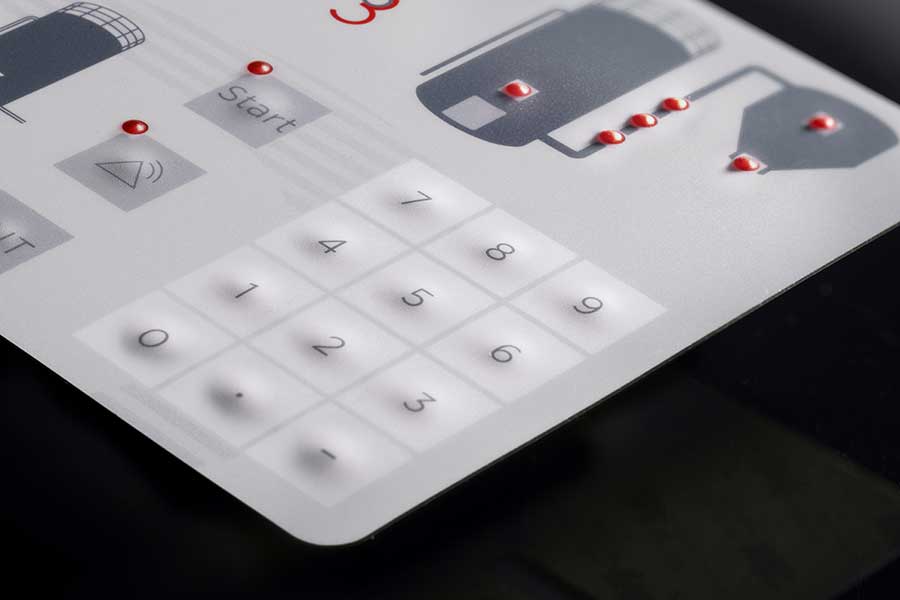How Membrane Switches Elevate User Experience in Tech Gadgets
Why Membrane Layer Switches Are Crucial for Sturdy Control Systems
Membrane layer buttons play a pivotal duty in making sure the sturdiness and integrity of control systems across numerous industries. As we explore the complex benefits of membrane switches, it becomes noticeable that their importance transcends simple capability, affecting user experience and operational performance.
Overview of Membrane Layer Switches
Membrane layer switches are versatile and reliable parts commonly made use of in different digital control systems. The visuals overlay offers both practical and aesthetic design, while the spacer layer guarantees that the buttons are turned on only when pressed.
Membrane layer buttons are often favored in applications needing a compact and lightweight design, making them optimal for handheld devices, clinical tools, and industrial machinery. They can be customized to satisfy details individual demands and can include different attributes such as backlighting, tactile feedback, and numerous colors. Membrane switches are resistant to dust, wetness, and pollutants, making them appropriate for settings where sturdiness is essential.
Advantages of Longevity
In numerous applications, the longevity of membrane layer switches deals significant benefits that improve their total performance and dependability. These buttons are designed to stand up to rough atmospheres, making them suitable for use in requiring problems such as high moisture, severe temperatures, and direct exposure to chemicals. Their robust construction aids to prevent damage from physical effect, making sure durable performance and reducing the demand for constant substitutes.
Additionally, membrane layer buttons are immune to wear and tear, which is essential in applications where frequent interaction happens. This longevity equates to decrease upkeep prices, as organizations benefit from lowered downtime and less solution disturbances. The encapsulated design of membrane switches over secures interior parts from dirt and moisture ingress, further contributing to their life-span (membrane switch).
Another benefit is their capability to preserve constant efficiency over time. With a high resistance for mechanical stress and anxiety, these switches maintain their responsive feedback and electrical honesty, making sure user fulfillment. Inevitably, the durability of membrane layer switches not only enhances functional effectiveness but likewise promotes self-confidence in their dependability, making them a favored selection for control systems throughout numerous sectors.
Applications in Different Industries
Sturdy control systems employing membrane layer buttons locate extensive applications across an array of industries, each profiting from the distinct features these buttons provide. In the clinical field, membrane layer switches are crucial for tools such as patient displays and diagnostic devices, where dependability and convenience of cleansing are critical. Their resistance to wetness and contaminants ensures they maintain functionality in sterilized atmospheres.
The auto sector leverages membrane layer switches for dashboard controls and infomercial systems, where they supply sleek, inconspicuous user interfaces that enhance user experience. These switches are likewise developed to stand up to rough problems, consisting of direct exposure to extreme temperature levels and vibrations.
In commercial settings, membrane layer switches are commonly utilized in machinery control board, offering responsive feedback and longevity required for high-usage applications. Their capacity to withstand chemicals makes them ideal for manufacturing settings where spills and contaminants are regular.

Consumer electronic devices, such as cooking area appliances and push-button controls, additionally utilize membrane buttons for check that their versatility and cost-effectiveness. Generally, the flexibility and robust nature of membrane changes make them vital across different markets, ensuring effective procedure and long life in control systems.
Design and Aesthetic Allure
While capability is paramount, the layout and visual allure of control systems equipped with membrane switches play a critical duty in customer interaction and general experience (membrane switch). The visual design of these buttons can significantly influence customer perception and communication. A properly designed membrane layer button improves the good looks of the tool, making it extra enticing to customers and cultivating a link in between the individual and the product
Membrane switches offer a lot of versatility in style, allowing manufacturers to customize graphics, shades, and appearances to straighten with brand identity and product aesthetic appeals. Using dynamic colors and distinctive patterns can attract focus, while responsive feedback can reinforce the user's communication with the tool. In addition, the capability to incorporate LED indications and backlighting right into the membrane layer switch style provides both useful and aesthetic benefits, boosting exposure and usability in numerous atmospheres.

Enhancing Individual Experience

Moreover, membrane switches can be tailored to incorporate graphical user interfaces, boosting usability by providing details in a clear and intuitive manner (membrane switch). This personalization can consist of symbols, labels, and color coding that guide individuals with facility functionalities easily. In addition, their convenience allows for combination in different atmospheres, making sure regular efficiency whether in commercial equipment or customer electronic devices
The resilience of membrane switches additionally plays a critical duty in customer experience. By holding up against harsh problems and prolonged use, look at these guys these switches reduce the likelihood of system failings, hence advertising dependability and individual confidence. Eventually, the calculated use membrane changes not only elevates capability yet likewise considerably enriches customer communication with control systems, making them an indispensable part in modern-day style.
Conclusion
